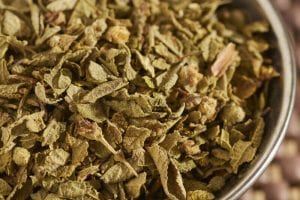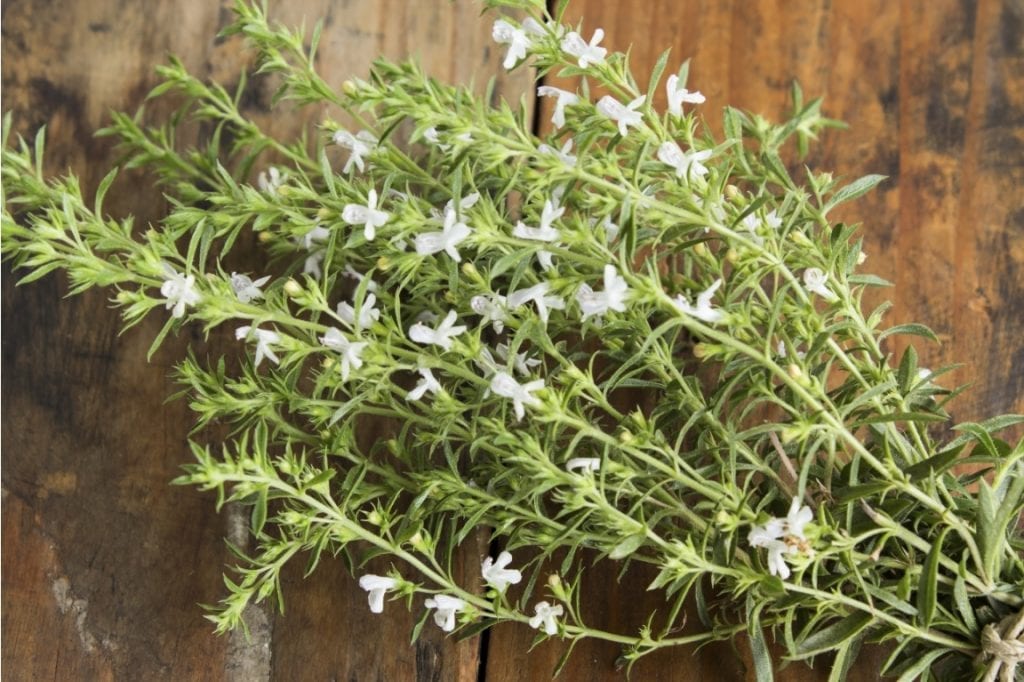
Whenever the word “savory” is mentioned, most would probably think of the delicious flavor first. Little do they know that there’s actually a famous plant called the savory herb! This herb gives various dishes (especially meat recipes) a distinct, peppery taste.
In this article, we’ll share with you everything there is to know about savory. What it is, where it came from, where it was used, and what its two main kinds are. We’ll also tell you its many health benefits, how to use it in cooking, and which dishes its flavor best suit.
Also, we’ve listed 4 amazing recipes that use the versatile herb in its ingredients. This is in case you want to personally experience how well it adds to a meal’s flavor. So, put your cooking hats on ‘cause we’re about to let you in on the amazing world of savory!
What Is Savory, The Herb?
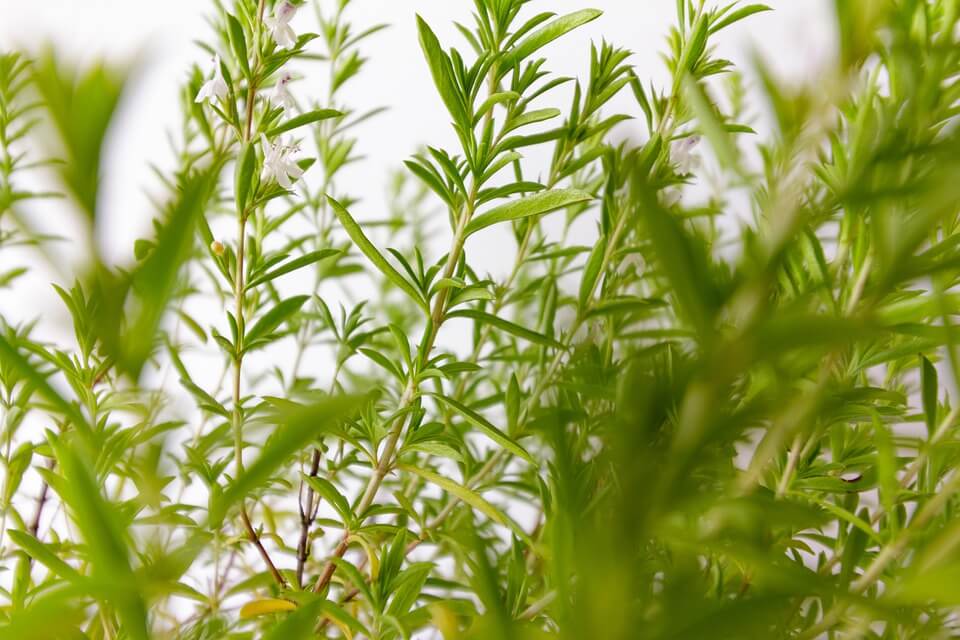
Savory is a herb that belongs to the mint family. Herbs, like savory, are the leafy parts of plants that are used to add flavor to all kinds of food. This plant is small, with green leaves and blooming flowers.
While it’s native to the Mediterranean region, this herb has also been naturalized in other places, like Great Britain. As such, it has been used to add flavor to countless cultures’ cuisines.
Origins of Savory
For thousands of years, people have used this herb to enhance the flavor of their dishes. Ancient Romans and Greeks used the plant as far back as 2000 years ago, cultivating and using them in their cuisine.
In fact, it was a very popular herb in Europe, acting as a sort of precursor for pepper due to its similar taste. Even Ancient Romans used it before the spice route from Asia could introduce the now universal black pepper. Aside from seasoning, this herb also had other notable uses. The Ancient Romans dubbed it the “herb of love”, using it to make love potions and as aphrodisiacs, too.
In more recent history, Germans also used savory as a pepper replacement when a shortage occurred in World War 2. They picked it for its notable “peppery” taste. Until now, some Germans continue this practice, using the herb instead of pepper for their traditional dishes. Needless to say, it’s an essential plant used in both the past and up until the present time.
The Two Main Kinds: Summer Savory vs. Winter Savory
The savory plant has up to 30 different types! However, only two main varieties are used as spices for cooking: the summer savory and the winter savory. While the two share similarities, there are also notable differences.
Summer Savory (Satureja hortensis)
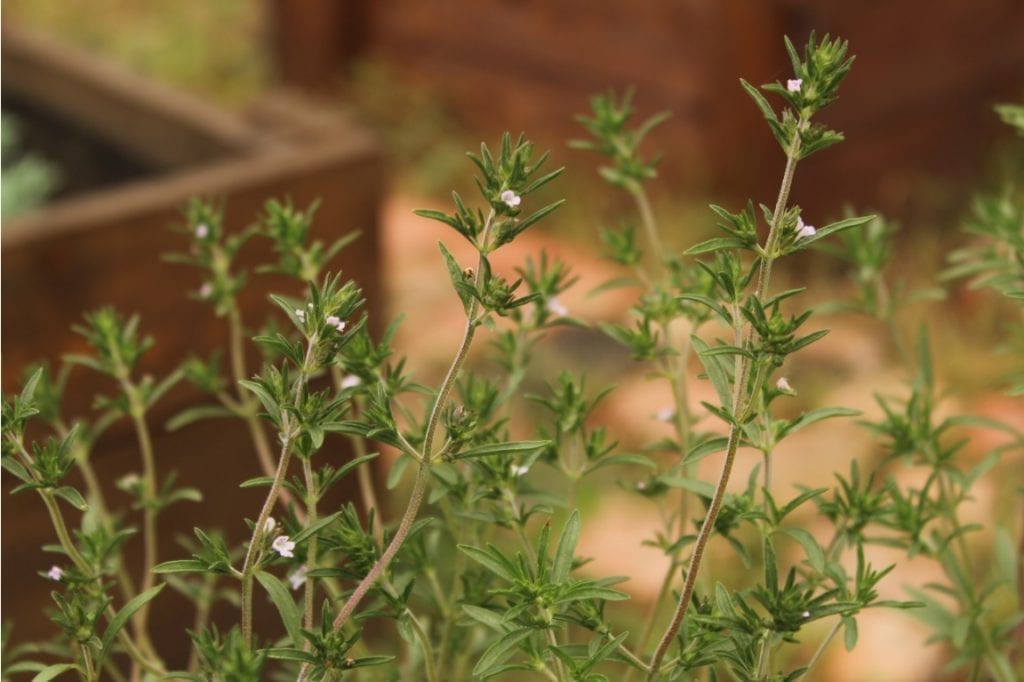
The summer savory, scientific name Satureja hortensis, is the most popular and commonly used type of savory plant.
It’s an annual plant, which means that it completes its whole life cycle in just one growing season. After growing, all its parts (from leaf to root) die every year. Hence, the term “annual”.
The summer variety has bronze and green-colored leaves and, like its winter counterpart, flowers. Its lilac tubular flowers bloom from the months of July to September.
The summer type is used in all kinds of dishes and even mixed in with other dried herbs, like in herbes de Provence. It’s used in many traditional dishes in Bulgarian and Romanian cuisine, and is a popular herb in Atlantic Canada.
Many prefer the summer savory because of its sweeter taste and smell. While the two main types taste similar, the summer variety has a lighter, sweet, and spicy flavor and aroma. More specifically, it has that warm, peppery taste the herb is most known for. Because of the summer variety’s popularity, it’s more commonly cultivated, and can be bought all year-round in stores.
Winter Savory (Satureja montana)

The winter savory, also known as the mountain savory, is the other major kind of savory. It’s a perennial plant, meaning it grows and lives for many growing seasons.
The winter variety’s leaves have a darker shade of green compared to its summer counterpart. It also has summer flowers whose colors range from light lavender to pink or even white.
The winter kind has a stronger, more bitter flavor compared to the summer savory. It’s generally thought of as having a more earthy and somber taste. Its smell is also reminiscent of scents associated with the winter season, with hints of sage and pine.
This winter type grows on rocks on the sides of hills and mountain slopes in the Mediterranean region. It’s also been found growing on cracks along old walls and dry banks as well. This may be why it garnered the alternate name mountain savory, and Satureja montana (“montana” meaning mountains).
It’s very easy to grow in temperate regions, and is native to not just the Mediterranean region, but to Southern Europe and Africa, too.
Health Benefits of The Savory Herb
This herb is not only good for adding flavor to dishes. It also comes with all kinds of health benefits!
- Good for the Digestive System – Eating the plant can help promote a healthy digestive system. It prevents indigestion and gas from forming in your stomach. It makes it easier for your stomach to expel gas as well.
- Remedy for Digestive Problems – It has also been shown to help relieve symptoms of many digestive problems. These include diarrhea, gastro-enteritis, and even colic.
- A Natural Antiseptic – It has an essential oil called thymol which contains antiseptic and antifungal properties. These properties can help treat bee stings and other kinds of insect bites.
- Relieves Symptoms of Coughs and Colds – Many use this plant to help treat symptoms of cough and cold, such as sore throat, thanks to its antibacterial properties. It also has Vitamin C which helps the body naturally protect itself against viruses and other free radicals.
- Eases Joint Pain Experienced from Arthritis – Select ointments can externally relieve joint pain caused by arthritis. Some of these contain the savory plant.
- Natural Aphrodisiac – Like the Ancient Romans, many people still use the savory plant as a natural aphrodisiac.
- Prevents Diseases and Promotes Overall Health – This plant has antioxidants which can help prevent diseases from even forming in the first place. One example is its ability to lower bad cholesterol and increase good cholesterol levels in the body. This helps promote heart health and stop heart diseases from developing. Curious to know more about cholesterol and how it affects one’s health? Check out our article, 10 Healthy Recipes For A Low Cholesterol Diet.
A Word Of Caution: Like other herbs, pregnant women aren’t encouraged to use the savory herb. Consult your doctor first before adding it to one’s dishes.
Where and How to Use Savory in Cooking

There are many ways to use the aromatic herb in cooking your meals. But first, here is a list of food that go well seasoned with the savory herb.
What Food Goes Well With Savory?
Both the summer and winter varieties are used to season many similar types of food and dishes. These include poultry meats like chicken, turkey, goose, and duck. They’re also added on pork, lamb, and fish meat dishes, from sausages, pies, stews, and grilled barbeque meat. Savory is also popularly used on beans.
However, summer savory is usually paired with lighter dishes like eggs and summer vegetables. Meanwhile, winter savory is normally used to add flavor to heartier foods, from fatty fish to stuffings, and even winter root vegetables.
4 Ways to Use The Savory Herb in Cooking
And here are some of the ways you can use the herb in your everyday cooking:
- Substitute for Pepper and/or Salt – use the plant like the Germans did! There may not be a pepper shortage now, but you can still use savory to season your meat or bean dishes. The Romans also once used the herb as a replacement for salt, so this useful herb is ideal for you if you’re on a low-sodium diet.
- Use it like Herbes de Provence – savory is the main ingredient of the dried herb mixture, herbes de Provence. This mixture is usually sprinkled on meat before roasting and grilling. It’s also added to oil for a truly flavorful meal. You can easily do the same with savory.
- Use in Meat Rubs – rubbing the savory herb on pork and chicken before cooking can help give the meat a unique, flavorful taste. If you want to give your food a peppery taste, then try using the savory plant.
- Table Condiment – In Bulgaria, the herb is mixed with a bowl of salt and ground paprika. This makes a table condiment called sharena sol, which translates to “colorful salt”. Sharena sol is used to add flavor to many Bulgarian dishes. It’s also often added to bread, potatoes and other vegetables, as well as cheese.
Keep in Mind: The winter variety loses much of its flavor if cooked for too long. So, it’s better to use the summer variety for meals that require a long cooking time.
4 Flavorful Recipes that Use Savory
Now you know which food savory best goes with, as well as the ways it can be used. Let’s then look into 4 amazing recipes that use this flavorful herb in its ingredients!
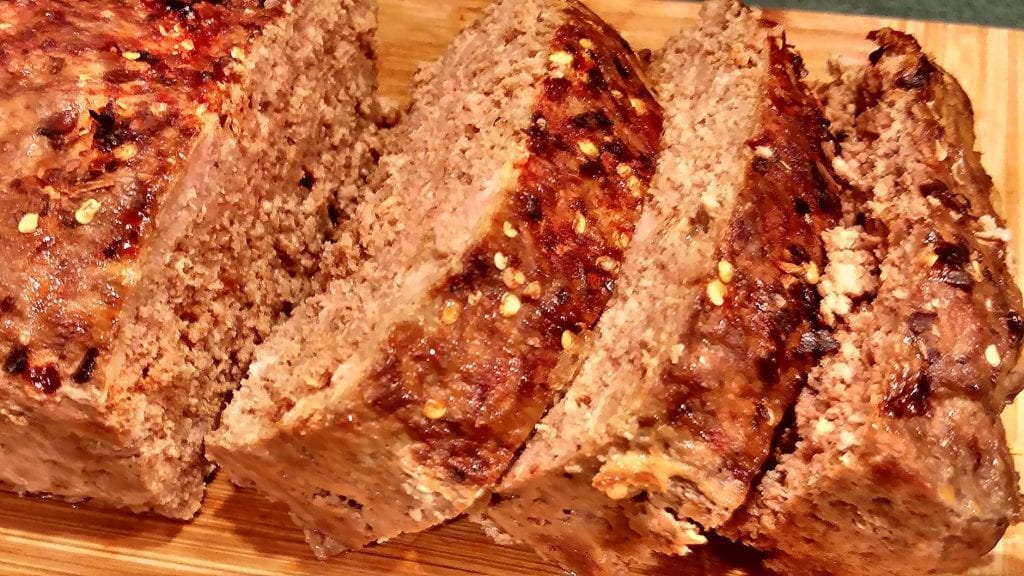
Meatloaf is every mom’s favorite go-to dish for a reason. This Savory Turkey Meatloaf is a lighter, low-fat version that replaces the usual ground beef with ground turkey.
But just because it’s healthier doesn’t mean it lacks flavor, as this recipe uses plenty of spices and seasonings to enhance the dish’s taste. And what better way to do that than by using some delicious savory herb? Aside from said herb, the meatloaf is also seasoned with sage, soy sauce, sesame oil, and paprika.

Who says you can’t add this herb to pasta? In this recipe, the use of savory adds a wonderful dimension to an already spicy sauce inspired by Ruby Tuesday. And it works, because there’re also deliciously cooked chicken breast and beans in this pasta. Give this scrumptious copycat chicken pasta recipe a try once you’ve bought the summer variety.

Shawn Brandow | Flickr.com
Here’s another delicious, well-seasoned chicken pasta dish for you to try. In this recipe, it’s triple the pepper-goodness with the use of Bird’s eye chili, white pepper, and summer savory. These spices give the linguini pasta, bacon, and chicken an incredible boost of peppery flavor that you’ll surely love.
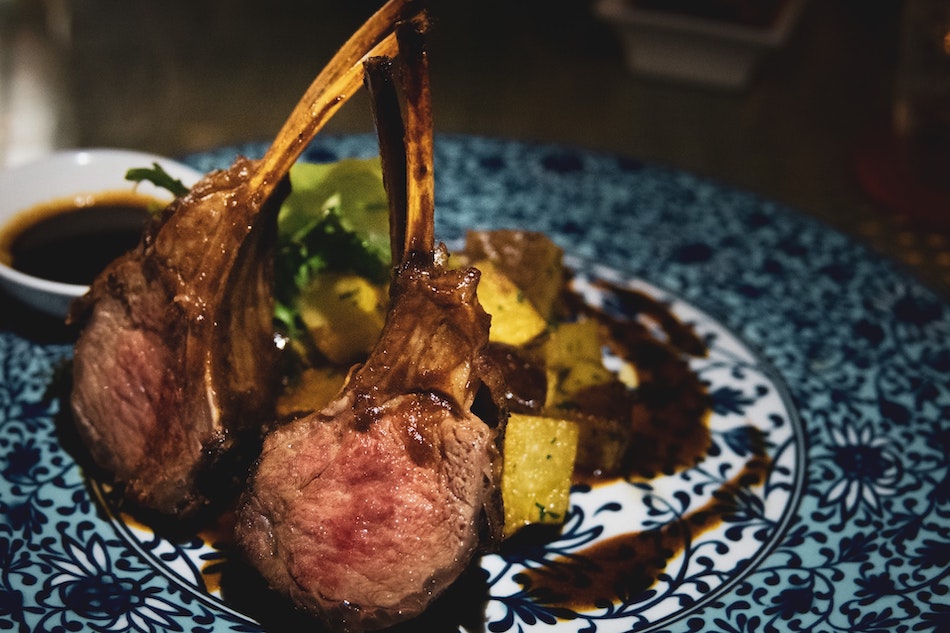
We can’t end this list without a perfectly-seasoned tender lamb. And in this recipe, roasted lamb leg meets the best herb combination: thyme, savory, and rosemary. This intense herb flavor really suits the roasted lamb, potatoes, and onions.
Substitute Herbs for Savory
If you want to try making the recipes mentioned but don’t have any savory, then don’t worry. There are a number of popular herbs you can use as a substitute.
- Thyme – Thyme is one of the most popular spices in the world. Its taste is also the closest to that of savory, with the same minty flavor. To add, you can even substitute it in a 1:1 ratio. You can use either dried or fresh thyme for your cooking.
- Sage – Like the mint plant, sage has the same winter scents as pine. It also grows in the Mediterranean, and it has a similar taste. But if you want something that tastes just like savory, then it’s best to use fresh sage leaves.
- Marjoram – Marjoram can be your last option in case thyme and sage isn’t available. However, its taste is closer to that of thyme and oregano. Like the winter variety, marjoram is a fragile herb. So, home chefs should avoid cooking it for long periods.
But! If you wish to really replicate the true taste of savory, then use 2 parts fresh thyme to 1 part fresh sage.
To Sum It Up
Savory is a versatile herb. Many cuisines use it as a seasoning on many of their dishes. It has a wonderful, sweet, and spicy, peppery taste, and contains various health benefits.
The delicious herb goes well with a lot of food, but it tastes best added to meats, beans, poultry, and stuffing or breadcrumbs. Try some of our suggested recipes to experience just how well savory enhances the taste of one’s dishes.
